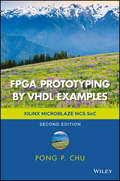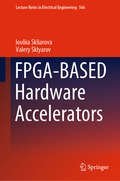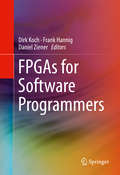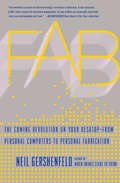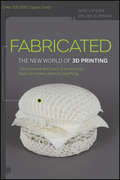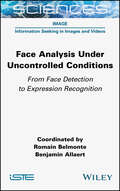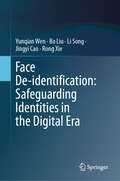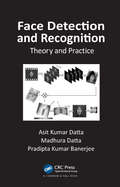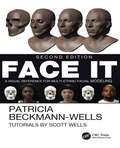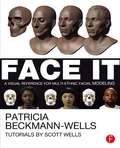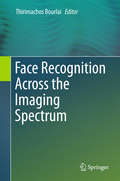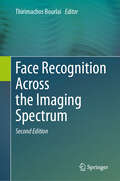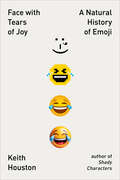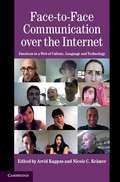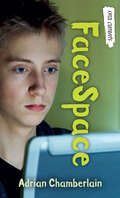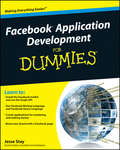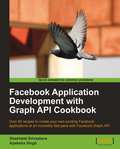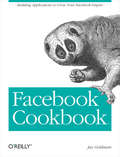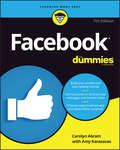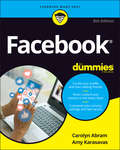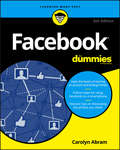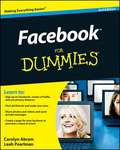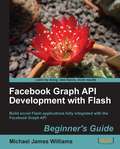- Table View
- List View
FPGA Prototyping by VHDL Examples: Xilinx Microblaze Mcs Soc
by Pong P. ChuA hands-on introduction to FPGA prototyping and SoC design This Second Edition of the popular book follows the same “learning-by-doing” approach to teach the fundamentals and practices of VHDL synthesis and FPGA prototyping. It uses a coherent series of examples to demonstrate the process to develop sophisticated digital circuits and IP (intellectual property) cores, integrate them into an SoC (system on a chip) framework, realize the system on an FPGA prototyping board, and verify the hardware and software operation. The examples start with simple gate-level circuits, progress gradually through the RT (register transfer) level modules, and lead to a functional embedded system with custom I/O peripherals and hardware accelerators. Although it is an introductory text, the examples are developed in a rigorous manner, and the derivations follow strict design guidelines and coding practices used for large, complex digital systems. The new edition is completely updated. It presents the hardware design in the SoC context and introduces the hardware-software co-design concept. Instead of treating examples as isolated entities, the book integrates them into a single coherent SoC platform that allows readers to explore both hardware and software “programmability” and develop complex and interesting embedded system projects. The revised edition: Adds four general-purpose IP cores, which are multi-channel PWM (pulse width modulation) controller, I2C controller, SPI controller, and XADC (Xilinx analog-to-digital converter) controller. Introduces a music synthesizer constructed with a DDFS (direct digital frequency synthesis) module and an ADSR (attack-decay-sustain-release) envelop generator. Expands the original video controller into a complete stream-based video subsystem that incorporates a video synchronization circuit, a test pattern generator, an OSD (on-screen display) controller, a sprite generator, and a frame buffer. Introduces basic concepts of software-hardware co-design with Xilinx MicroBlaze MCS soft-core processor. Provides an overview of bus interconnect and interface circuit. Introduces basic embedded system software development. Suggests additional modules and peripherals for interesting and challenging projects. The FPGA Prototyping by VHDL Examples, Second Edition makes a natural companion text for introductory and advanced digital design courses and embedded system course. It also serves as an ideal self-teaching guide for practicing engineers who wish to learn more about this emerging area of interest.
FPGA-BASED Hardware Accelerators (Lecture Notes in Electrical Engineering #566)
by Valery Sklyarov Iouliia SkliarovaThis book suggests and describes a number of fast parallel circuits for data/vector processing using FPGA-based hardware accelerators. Three primary areas are covered: searching, sorting, and counting in combinational and iterative networks. These include the application of traditional structures that rely on comparators/swappers as well as alternative networks with a variety of core elements such as adders, logical gates, and look-up tables. The iterative technique discussed in the book enables the sequential reuse of relatively large combinational blocks that execute many parallel operations with small propagation delays. For each type of network discussed, the main focus is on the step-by-step development of the architectures proposed from initial concepts to synthesizable hardware description language specifications. Each type of network is taken through several stages, including modeling the desired functionality in software, the retrieval and automatic conversion of key functions, leading to specifications for optimized hardware modules. The resulting specifications are then synthesized, implemented, and tested in FPGAs using commercial design environments and prototyping boards. The methods proposed can be used in a range of data processing applications, including traditional sorting, the extraction of maximum and minimum subsets from large data sets, communication-time data processing, finding frequently occurring items in a set, and Hamming weight/distance counters/comparators. The book is intended to be a valuable support material for university and industrial engineering courses that involve FPGA-based circuit and system design.
FPGAs for Software Programmers
by Dirk Koch Frank Hannig Daniel ZienerThis book makes powerful Field Programmable GateArray (FPGA) and reconfigurable technology accessible to software engineers bycovering different state-of-the-art high-level synthesis approaches (e. g. ,OpenCL and several C-to-gates compilers). It introduces FPGA technology, itsprogramming model, and how various applications can be implemented on FPGAswithout going through low-level hardware design phases. Readers will get arealistic sense for problems that are suited for FPGAs and how to implementthem from a software designer's point of view. The authors demonstrate that FPGAs and their programming model reflectthe needs of stream processing problems much better than traditional CPU or GPUarchitectures, making them well-suited for a wide variety of systems, fromembedded systems performing sensor processing to large setups for Big Datanumber crunching. This book serves as aninvaluable tool for software designers and FPGA design engineers who are interestedin high design productivity through behavioural synthesis, domain-specificcompilation, and FPGA overlays. Introduces FPGA technology to softwaredevelopers by giving an overview of FPGA programming models and design tools,as well as various application examples; Provides a holistic analysis of the topic andenables developers to tackle the architectural needs for Big Data processingwith FPGAs; Explains the reasons for the energy efficiencyand performance benefits of FPGA processing; Provides a user-orientedapproach and a sense for where and how to apply FPGA technology.
FWD This Link: A Rough Guide to Staying Amused Online When You Should Be Working
by Peter Buckey Rhodri MarsdenFrom skate-boarding dogs to Arnold Schwarzenegger photoshopped into a swimsuit and sat on George Bush's lap, FWD This Link brings together the biggest distractions of the past decade into an addictive user-friendly Rough Guide. Rhodri Marsden, Technology columnist for the Independent and guru on the webs weirdest, shares the coolest virals and hoaxes and the funniest YouTube clips. Discover the unsuspecting internet stars, and the reason why we loved them from the Star Wars Kid to the Numa Numa guy. The guide is packed with the webs most entertaining wildlife including fainting goats and frisky donkeys. Let's not forget the power of the email and those living to regret clicking the "send" button, only for their heart-felt love letters to be splashed across the press the next morning. Those wonderful websites that have you coming back again and again, brow-furrowing collections, online museums and shopping sites that defy belief -- they're all here to keep you amused online when you should be working. Warning: This book will not help you clear your Inbox.
Fab: The Coming Revolution on Your Desktop--from Personal Computers to Personal Fabrication
by Neil GershenfeldWhat if you could someday put the manufacturing power of an automobile plant on your desktop? According to Neil Gershenfeld, the renowned MIT scientist and inventor, the next big thing is personal fabrication-the ability to design and produce your own products, in your own home, with a machine that combines consumer electronics and industrial tools. Personal fabricators are about to revolutionize the world just as personal computers did a generation ago, and Fab shows us how.
Fabricated
by Hod Lipson Melba KurmanFabricated tells the story of 3D printers, humble manufacturing machines that are bursting out of the factory and into schools, kitchens, hospitals, even onto the fashion catwalk. Fabricated describes our emerging world of printable products, where people design and 3D print their own creations as easily as they edit an online document.A 3D printer transforms digital information into a physical object by carrying out instructions from an electronic design file, or 'blueprint.' Guided by a design file, a 3D printer lays down layer after layer of a raw material to 'print' out an object. That's not the whole story, however. The magic happens when you plug a 3D printer into today's mind-boggling digital technologies. Add to that the Internet, tiny, low cost electronic circuitry, radical advances in materials science and biotech and voila! The result is an explosion of technological and social innovation.Fabricated takes the reader onto a rich and fulfilling journey that explores how 3D printing is poised to impact nearly every part of our lives.Aimed at people who enjoy books on business strategy, popular science and novel technology, Fabricated will provide readers with practical and imaginative insights to the question 'how will this technology change my life?' Based on hundreds of hours of research and dozens of interviews with experts from a broad range of industries, Fabricated offers readers an informative, engaging and fast-paced introduction to 3D printing now and in the future.
Face Analysis Under Uncontrolled Conditions: From Face Detection to Expression Recognition
by Romain Belmonte Benjamin AllaertFace analysis is essential for a large number of applications such as human-computer interaction or multimedia (e.g. content indexing and retrieval). Although many approaches are under investigation, performance under uncontrolled conditions is still not satisfactory. The variations that impact facial appearance (e.g. pose, expression, illumination, occlusion, motion blur) make it a difficult problem to solve.This book describes the progress towards this goal, from a core building block – landmark detection – to the higher level of micro and macro expression recognition. Specifically, the book addresses the modeling of temporal information to coincide with the dynamic nature of the face. It also includes a benchmark of recent solutions along with details about the acquisition of a dataset for such tasks.
Face De-identification: Safeguarding Identities in the Digital Era
by Bo Liu Jingyi Cao Li Song Yunqian Wen Rong XieThis book provides state-of-the-art Face De-Identification techniques and privacy protection methods, while highlighting the challenges faced in safeguarding personal information. It presents three innovative image privacy protection approaches, including differential private k-anonymity, identity differential privacy guarantee and personalized and invertible Face De-Identification. In addition, the authors propose a novel architecture for reversible Face Video De-Identification, which utilizes deep motion flow to ensure seamless privacy protection across video frames. This book is a compelling exploration of the rapidly evolving field of Face De-Identification and privacy protection in the age of advanced AI-based face recognition technology and pervasive surveillance. This insightful book embarks readers on a journey through the intricate landscape of facial recognition, artificial intelligence, social network and the challenges posed by the digital footprint left behind by individuals in their daily lives. The authors also explore emerging trends in privacy protection and discuss future research directions. Researchers working in computer science, artificial intelligence, machine learning, data privacy and cybersecurity as well as advanced-level students majoring in computers science will find this book useful as reference or secondary text. Professionals working in the fields of biometrics, data security, software development and facial recognition technology as well as policymakers and government officials will also want to purchase this book.
Face Detection and Recognition: Theory and Practice
by Asit Kumar Datta Madhura Datta Pradipta Kumar BanerjeeFace detection and recognition are the nonintrusive biometrics of choice in many security applications. Examples of their use include border control, driver's license issuance, law enforcement investigations, and physical access control.Face Detection and Recognition: Theory and Practice elaborates on and explains the theory and practice of face de
Face It: A Visual Reference for Multi-Ethnic Facial Modeling
by Patricia Beckmann-Wells Scott WellsAs animation software becomes more advanced and graphics become more refined, the opportunity to create informative detail becomes more achievable in your characters. You can’t give every character the same facial contours anymore. Today’s graphic engines and hi-definition screens enhance detail, and the features in your character can make or break the believability of your game or movie.Face It provides you with the resources that you need to ensure an accurate character model. By examining the skulls of people of different ages, ethnicities, and geographical areas, authors Patricia Beckmann-Wells and Scott Wells showcase the intricacies of the human head and face and show you how to apply that to your models.This Second Edition features new and updated tutorials as well as a new chapter discussing facial variation over time. Whether it be a Caucasian woman in her 50s or an African man in his late 20s, you’ll know how to properly shape a forehead, an eye socket, and even cheekbones to ensure the 100% accuracy of your 3D character.
Face It: A Visual Reference for Multi-ethnic Facial Modeling
by Patricia Beckmann WellsFace It presents practical hands-on techniques, 3D modeling and sculpting tools with Maya and ZBrush production pipelines, uniquely focused on the facial modeling of 7 ethnicity models, featuring over 100 different models ranging in age from newborn to elderly characters. Face It is a resource for academic and professionals alike. Explore the modeling possibilities beyond the digital reference galleries online. No more having to adapt medical anatomy texts to your own models! Explore the finite details of facial anatomy with focus on skull development, muscle structure, ears, eyes, nose and mouth paired with side by side comparisons of reference photos, anatomical construction and chapter focused 3D tutorials.
Face Recognition Across the Imaging Spectrum
by Thirimachos BourlaiThis authoritative text/reference presents acomprehensive review of algorithms and techniques for face recognition (FR),with an emphasis on systems that can be reliably used in operationalenvironments. Insights are provided by an international team of pre-eminentexperts into the processing of multispectral and hyperspectral face imagescaptured under uncontrolled environments. These discussions cover a variety ofimaging sensors ranging from state-of-the-art visible and infrared imagingsensors, to RGB-D and mobile phone image sensors. A range of differentbiometric modalities are also examined, including face, periocular and iris. Thistimely volume is a mine of useful information for researchers, practitionersand students involved in image processing, computer vision, biometrics andsecurity.
Face Recognition Across the Imaging Spectrum
by Thirimachos BourlaiEmbark on a journey through the recent groundbreaking developments in face recognition (FR) systems with our second edition. Initially designed for controlled conditions, FR systems have evolved to conquer real-world challenges, adapting to low-light scenarios and extended distances. Our book delves into the transformation brought about by advancements in imaging sensors and cost-effective infrared (IR) cameras, exploring intensified near-infrared (NIR), shortwave IR (SWIR), middle-wave IR (MWIR), and long-wave IR (LWIR) imagery. This edition caters to the burgeoning interest in FR technologies, aligning with recent strides in computer vision, pattern recognition, and biometric analysis. Tailored for biometrics researchers, practitioners, and students, it addresses the critical need for FR algorithms in operational environments. Our book encompasses three comprehensive sections: (a) Face Recognition and Biometric Systems: Dive into topics such as face profile, facial attractiveness, periocular and binocular recognition, and quality training for face-based examinations. (b) Biometric System Security and Attacks: Explore adversarial attacks, domain transformers, demographic fairness, ocular pathologies, and distance-based classification of biometric images. (c) Biometric Image Synthesis and Technology Enhancements:Uncover the secrets of face image synthesis, thermal band head pose estimation, facial image analysis in forensic examination, and optimal computer monitor configurations. With 13 meticulously crafted chapters, this edition provides updated insights, experimental findings, and a roadmap for the future. Each chapter delivers a rich exploration of its specific topic, weaving together background information, literature reviews, methodologies, experiments, and concluding with challenges and future directions. Elevate your understanding of evolving face recognition technologies – the future awaits!
Face with Tears of Joy: A Natural History of Emoji
by Keith HoustonA vibrant exploration of the world’s newest language—where it came from, how it works, and where it’s going. We are surrounded by emoji. They appear in politics, movies, drug deals, our sex lives, and more. But emoji’s impact has never been explored in full. In this rollicking tech and pop culture history, Keith Houston follows emoji from its birth in 1990s Japan, traces its Western explosion in the 2000s, and considers emoji’s ever-expanding lexicon. Named for the world’s most popular pictogram, Face with Tears of Joy tells the whole story of emoji for the first time.
Face-to-Face Communication over the Internet
by Arvid Kappas Nicole C. KrämerSocial platforms such as MySpace, Facebook and Twitter have rekindled the initial excitement of cyberspace. Text-based, computer-mediated communication has been enriched with face-to-face communication such as Skype, as users move from desktops to laptops with integrated cameras and related hardware. Age, gender and culture barriers seem to have crumbled and disappeared as the user base widens dramatically. Other than simple statistics relating to e-mail usage, chatrooms and blog subscriptions, we know surprisingly little about the rapid changes taking place. This book assembles leading researchers on nonverbal communication, emotion, cognition and computer science to summarize what we know about the processes relevant to face-to-face communication as it pertains to telecommunication, including video-conferencing. The authors take stock of what has been learned regarding how people communicate, in person or over distance, and set the foundations for solid research helping to understand the issues, implications and possibilities that lie ahead.
FaceSpace (Orca Currents)
by Adrian ChamberlainDanny McBride is not the coolest kid in school, not in his wildest dreams. And if the other kids knew he spent his Saturday nights playing Parcheesi with his mom and working on a city made of Lego, he'd be even less cool. Danny wants more than anything to be popular. He creates a fictional British rocker named James and befriends him publicly online, hoping his make-believe friend's cool will rub off. It works. Danny starts making friends and feeling like part of the crowd—until people start wanting to meet the imaginary friend, and Danny's plan starts to unravel. This short novel is a high-interest, low-reading level book for middle-grade readers who are building reading skills, want a quick read or say they don’t like to read! The epub edition of this title is fully accessible.
Facebook Application Development For Dummies
by Jesse StayA fun and easy guide to creating the next great Facebook app!Want to build the next runaway Facebook app like Farmville or Mafia Wars? Interested in leveraging Facebook app development as part of a marketing strategy? Whether you want to build your own Facebook app from scratch, extend an existing Facebook app, or create a game, this book gets you up and running in no time. Master the Facebook toolkit, get acquainted with the Facebook Markup and Query languages, navigate the Facebook API--even learn how to make money with your new app!Shows you how to build the next great Facebook application with just basic HTML and scripting skillsDelves into what makes a good app and what makes a lucrative appExplores how to create Facebook apps for marketing and viral reach, creating apps that can make money, and Facebook game developmentReviews the Facebook toolkit and gets you started with the My First Facebook applicationCovers Facebook Markup and Query languages, navigating the Facebook API, and how to create a compelling interfaceCreate the next killer Facebook app with this approachable, fun guide!
Facebook Application Development with Graph API Cookbook
by Shashwat Srivastava Apeksha SinghWritten in a cookbook style, this book offers solutions using a recipe-based approach. Each recipe contains step-by-step instructions followed by an analysis of what was done in each task and other useful information. The cookbook approach means you can dive into whatever recipes you want in no particular order. The book provides tips and tricks to the most common problems and scenarios faced in Facebook Application Development. This book is written for Facebook developers ranging from novice to expert. It uses PHP, HTML and jQuery, the most commonly used platforms, to build applications in Facebook.
Facebook Cookbook: Building Applications to Grow Your Facebook Empire
by Jay GoldmanWant to build Facebook applications that truly stand out among the thousands already available? In addition to providing easy-to-follow recipes that offer practical ways to design and build scalable applications using the Facebook Platform and its new profile design, this Cookbook also explains proven strategies for attracting users in this highly competitive environment. With plenty of examples and practical solutions, Facebook Cookbook answers some of the hardest questions Facebook application developers contend with -- including how and where to get started. This Cookbook will help you:Learn to build an application that scales to accommodate a sudden influx of usersExplore changes from Facebook's old profile design to the new look and feelTake advantage of new integration points in the new profile designGet tips for designing applications with hosting and deployment costs in mindDiscover which widgets and controls to use for building the most attractive user interface designLearn the differences between standard HTML, JavaScript, and SQL, and the versions used on the Facebook PlatformTarget large, defined groups on Facebook, including those who want to find jobs, hire employees, market a business, advertise, and moreIf you can build simple web applications with HTML, Facebook Cookbook will help you build applications with the potential to reach millions of users around the globe. Learn what it takes to design applications that stand above the rest.
Facebook For Dummies
by Carolyn Abram Amy KarasavasTake control of your Facebook profile When you join Facebook, you're joining a community with over two billion people spread around the globe. It helps to have the insight on not only how to set up your profile and add content, but also how to make sure you control who sees—and doesn't see—your posts. Facebook For Dummies provides the trusted guidance you need to set up a profile, add content, and apply the many tools Facebook provides to give you control of your content. Primarily known as a way for individuals to share information, photos and videos, and calendar invitations, Facebook has gained prominence as a means to spread news, market products, and serve as a business platform. Whatever you’re looking to use it for, this book shows you how to use all the features available to make it a more satisfying experience. Build your profile and start adding friends Use Facebook to send private messages and instant notes Discover ways to set privacy and avoid online nuisances Launch a promotion page Get ready to have a whole lot of fun on the largest social network in the world.
Facebook For Dummies
by Carolyn Abram Amy KarasavasBe a new face on Facebook! If you're new to the Facebook user community, don't be shy: you're joining around 2.7 billion users (roughly two-and-a-half Chinas) worldwide, so you'll want to make sure you’re being as sociable as possible. And with more functionality and ways to say hello—like 3-D photos and Video Chat rooms—than ever before, Facebook For Dummies is the perfect, informative companion to get and new and inexperienced users acquainted with the main features of the platform and comfortable with sharing posts, pictures (or whatever else you find interesting) with friends, family, and the world beyond! In a chatty, straightforward style, your friendly hosts, Carolyn Abram and Amy Karasavas—both former Facebook employees—help you get settled in with the basics, like setting up your profile and adding content, as well as protecting your privacy when you want to decide who can and can't see your posts. They then show you how to get involved as you add new friends, toggle your newsfeed, shape your timeline story, join groups, and more. They even let you in on ways to go pro and use Facebook for work, such as building a promo page and showing off your business to the world. Once you come out of your virtual shell, there'll be no stopping you! Build your profile and start adding friends Send private messages and instant notes Share your memories Tell stories about your day Set your privacy and curate your news feed Don't be a wallflower: with this book you have the ideal icebreaker to get the party started so you can join in with all the fun!
Facebook For Dummies
by Carolyn AbramThere's no time like the present: get started on Facebook today with this friendly beginner guide!Facebook is constantly changing and evolving, replacing old features and introducing new ones. And while it can difficult to keep up with everything that it has to offer, its ever-changing features allow you to jump in and get started at any time! This edition of the popular For Dummies guide to Facebook covers the latest updates and guides new users into the Facebook experience quickly and easily. It explores the new look for photos and videos, the updated features in messaging service, expanded options for Timeline user profile, updates to popular Facebook apps, and much more. Covers Facebook's relaunched mobile application and integration with Windows 8 Offers a straightforward approach to demystifying Facebook for newbiesFeatures expanded updates on the photo/video sharing services, timeline profile, and moreUpdates all the changes to existing Facebook apps that are used by millions of people every dayHelps Facebook newcomers get up to speed and use the site safely and confidently Facebook For Dummies, 5th Edition is the resource you need to get the most from your Facebook experience.
Facebook For Dummies, 3rd Edition
by Leah Pearlman Carolyn AbramThe perennial bestseller-now updated to cover the latest features of Facebook Facebook is forever evolving, with the goal of improved user interaction. This new edition catches you up on the latest privacy updates, interface redesign, and other new features and options that keep the site up to date and never leaves you bored. You'll discover helpful coverage of all the changes and updates that have occurred since the previous edition, as well as the newest features that Facebook offers. Reveals all the latest changes, updates, and new features of Facebook that have occurred since the previous edition Introduces you to getting started with Facebook by creating a profile, setting privacy features, and navigating the interface Encourages you to find friends, upload photos, fill out your profile, and make new friends Helps you get organized by using Facebook as a scheduler, creating specialized business pages, and joining groups Shows you how to use Facebook as a search tool, advertise on Facebook, and more If you're ready to face the music and get started with Facebook, then this is the book for you!
Facebook Graph API Development with Flash
by Michael James WilliamsThis step-by-step book gives you an empty shell of an AS3 Facebook RIA, and guides you through writing the Facebook interaction code by means of fun examples, exercises, and code snippets.This beginner's guide focuses on getting you through all the major learning points in a smooth, logical order. You'll also see how to avoid some common pitfalls. If you are an AS3 developer who wants to create applications and games that integrate with Facebook - either on the Facebook website itself or off it, then this book is for you. Even if you have no previous experience with Facebook, databases, or server-side programming , you can count on this book.
Facebook Marketing
by Mari Smith Chris TreadawayThe bestselling Sybex guide to marketing on Facebook, now fully updatedAs the second most-visited site on the web, Facebook offers myriad marketing opportunities and a host of new tools. This bestselling guide is now completely updated to cover all of the latest tools including Deals, sponsored stories, the Send button, and more. It explains how to develop a winning strategy, implement a campaign, measure results, and produce usable reports. Case studies, step-by-step directions, and hands-on tutorials in the popular Hour-a-Day format make this the perfect handbook for maximizing marketing efforts on Facebook.This revised guide fills you in on the latest Facebook conventions, tools, and demographics, and outlines the important strategic considerations for planning a campaignTakes you step by step through crafting an initial Facebook presence, developing an overall marketing strategy, setting goals, defining metrics, developing reports, and integrating your strategy with other marketing activitiesCovers using features such as events, applications, and pay-per-click advertisingIncludes case studies and directions for updating, monitoring, and maintaining your campaignThis popular guide is packed with up-to-date information to help you develop, implement, measure, and maintain a successful Facebook marketing program.
